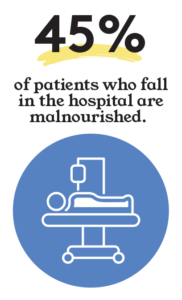Reduce Readmission Rates With Malnutrition Coding
How would you like to reduce readmission rates and potentially increase Medicare reimbursements? What if we told you that the key could be your foodservice provider?

Hospitals are motivated to reduce readmission rates to mainly reduce the financial stress these penalties impose. However, ACA readmission rates becoming transparent add another layer of pressure. Just like we read reviews before staying in a hotel or going to a restaurant, patients are beginning to research hospital’s ratings to decide whether they would like to seek care there or not.
There are many reasons why a patient returns to the hospital after discharge. They range from conditions like congestive heart failure and pneumonia, to behavioral and mental health issues, and housing instability. The list goes on, but we’re going to focus on the one we can have an impact on: malnutrition.
Almost fifty percent of hospitalized patients in the US are malnourished at the time of admission. Patients with malnutrition are more likely to develop complications such ashigher risk for pressure injuries, infections, falls, decrease in muscle strength, and poor wound healing.
These complications lead patients to have a longer length of stay, increase hospital costs associated with their treatment, and the likelihood of patients to be readmitted to the hospital within thirty days. Overall, it can increase the average cost of the hospitalization by 60%.

Malnutrition Coding at a Glance
The Inpatient Malnutrition Diagnosis & Reimbursement Program includes:
- comprehensive and secure online data analysis tool
- training materials to support clinical dietitians
- gap analysis

Our proprietary gap analysis methodology for malnutrition diagnosis utilizes existing data and compares it against national benchmarks to project outcomes that are dependent on a multitude of hospital-level variables.
If you want to learn how our Malnutrition Program can help you reduce readmission rates, please fill out the form below. We can estimate the potential for increased reimbursement when our program is fully implemented.
This blog is part one of a series of blogs dedicated to uncovering the impact of malnutrition on readmissions, length of stay, and revenue. Stay tuned for our second part!




